M.L. King
The Preacher
HISTORY OF FC BARCELONA
In the late 90s' of the 19th cenutry Swiss business men Hans (Joan) Gamper and his ten friends (Gualteri Wild, Lluís d'Ossó, Bartomeu Terrados, Otto Kunzle, Otto Maier, Enric Ducal, Pere Cabot, Carles Pujol, Josep Llobet, John Parsons and William Parsons) founded FC Barcelona. The exact date of foundation is the 29th November 1889.
Who was Hans (Joan) Gamper?

He was born in Winterthur, Switzerland on November 22, 1877. He was the eldest son born to August and Rosine Emma Gamper. Even as a young boy he showed great interest in sports especially for football,rugby,tennis and golf. He started his career in Fc Basel and was named club captain but then he moved first to France and in 1898 he went to Barcelona to visit his uncle. In 1899 he put a note in a local newspaper, trying to attract as many football players as possible to join the club; and just one monthe later he and his friends assembled at the historic gathering at the Gimnas Sole. The meeting was successful and the club was established and Englishman Gualteri Wild became the first President with Gamper as the first captain of the club.
Gualteri Wild:
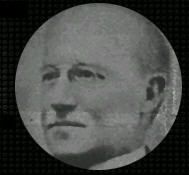
First team from 1901:
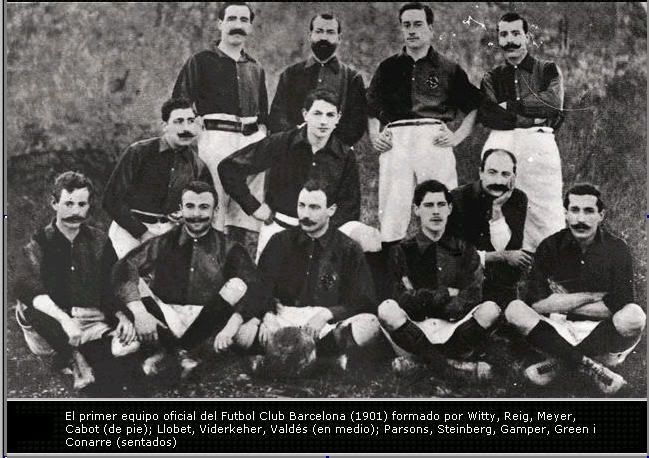
Symbols and kits through the course of history
First club symbol was the same as the town symbol:

In 1906 the club organized competition to chose the first club symbol which has changed through the course of history only in the period of Franco's regime (the club was called Club de Futbol Barcelona which can be seen on the symbol as well).
The club symbol represents the Cross of Saint Jordi – the patron saint of Barcelona; flag of Catalunia Senyera (national flag with 4 red lines on the golden background) and blue-red colour combination which Gamper took over from Fc Basel.

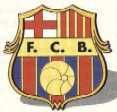
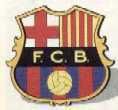
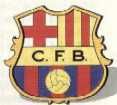
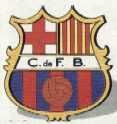

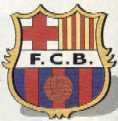
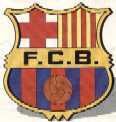
The first kit
From the start, the players wore the famous blue and claret colours, half the shirt one colour and half the other with the sleeves the opposite colour and white shorts.

Anthem of Fc Barcelona
[ur=lhttp://penya.fcbarcelonanyc.com/index.php?module=pagemaster&PAGE_user_op=view_page&PAGE_id=73]Anthem[/url]
The first match
In their first ever match, Barca played a team made up of English expatriates in Bonanova (now known as Turo Park). The English team, which actually included a number of Barca players, won 1-0. After the defeat moved several times from Bonanova to Casanova, Camp del Horta and Muntaner. In 1909 the club dwelled at stadium Industria which was the first field as the property of the club. The stadium capacity: 6000 spectators. Fc Barcelona played there for another 13 years.
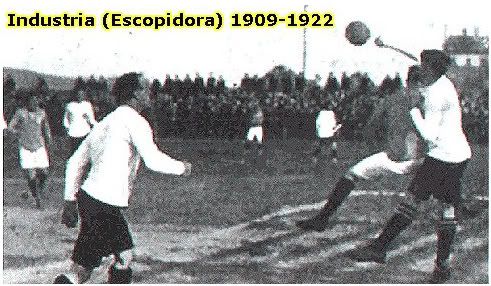
Les Corts
On 20, May 1922 Barca inaugurate their new stadium which was pretty modern for those times. At the begining the stadium received 30000 spectators and was later expanded to the capacity of 60000 viewers. Fc Barcelona played at Les Corts for 35 years.
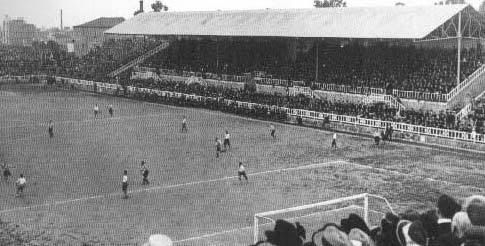
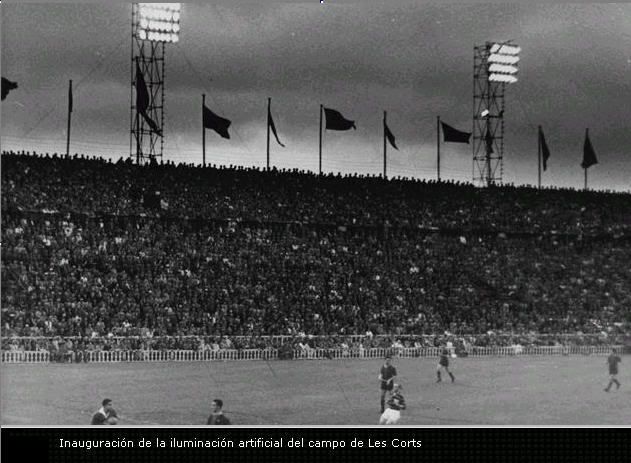
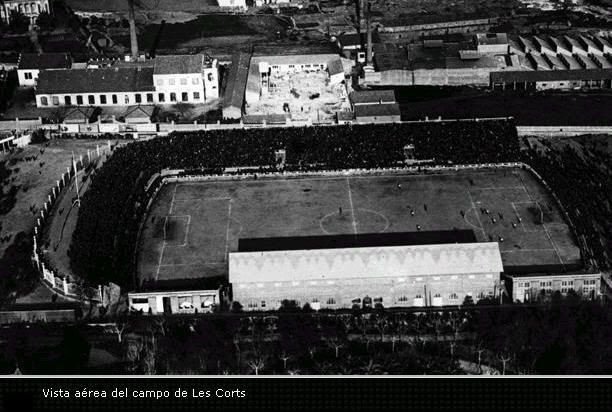
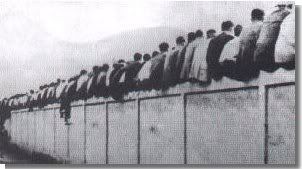
Gamper died on 30th July 1930 and the club went through difficult times for another 10 years because of political conditions in the country. In 1936 Franco's fascists killed the President of Fc Barcelona Josep Sunyol while the club was in America and managed to avoid the same fate. Betwixt the time of the civil war the number of members decreased to 4000 and in 1940 Franco nominated his own President the aristocrat in that time Enrique Pineyro who changed the name of the club into Club de Futbol Barcelona which stayed until the year of 1973 which was 2 years before Franco's death. Besides the alteration of the name Pineyro changed the club's symbols as well. He changed the Catalunia flag with Spanish one (only two lines).
People of Cataunia boiled with rage and Franco got frightened of the possible rebellion as the number of members was increasing with each day. Finally, the club sacked Pineyro and established their leadership. In next 5 years Barca won 3 Spanish trophies with Cesar, Velasco, Ramallets, Curto, brothers Gonzalvo and others at the head.
Barca celebrated their 50th anniversary in 1949 boosted by member numbers of 24,893 and boasting a total of 21 Catalan Championships, 9 cups and 4 Spanish League titles.
Kubala
Kubala nearly went to Madrid but the decisive moment to change his mind was when he had married daughter of Ferdinand Dauchik, who was in contacts with Josep Samitiers then scaut of the club, so he chose Barcelona at the end.
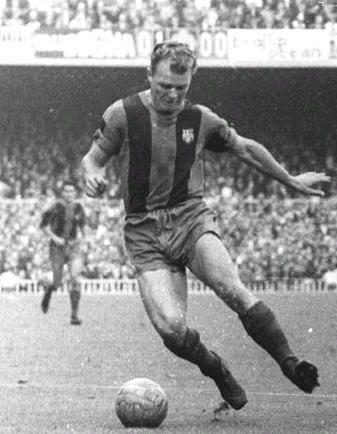
Kubala was huge talent and he scored 7 goals in a single match against Sporting Gijon in his first season in Barca (1951-1952). Barca won that same match 9-0. This season is regarded as the most successful one in the club's history (5 trophies). Next season Kubala played only few matches due to the consumption he had suffered from – but he miraculously returned and helped winning the League and the Cup title, he scored the decisive goal against Atletico in the final.
The Camp Nou
Ladislau Kubala was too huge a figure for Les Corts and the Club went on to open the doors of the Camp Nou (1957). Some of the greatest players in the world have graced its turf (Kubala, Cruyff, Maradona, Schuster, Ronaldo...) and in the 1990s it was the scene of some of the most spectacular football ever played, thanks to the unforgettable 'Dream Team'. And while the Club keeps growing, the stadium is continually being extended and improved.
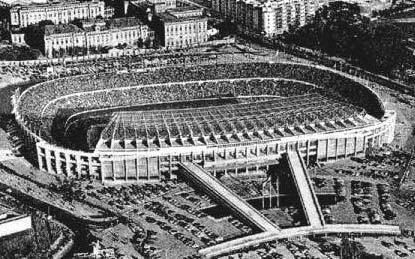
The first ticket:

1957- 49000 members (socios).
Coach: Helenio Herrera
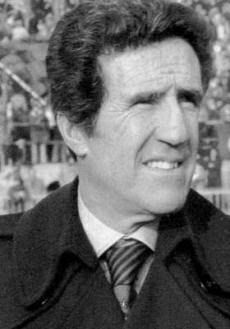
With Kubala, Martinez, Luis Suarez (the only Spaniard that won the best European player award), Gensana, Segarra, Evaristo and the Hungarian Kocsis and Czibor (both came on the initiative of Kubala) Barca ground everything that crossed its path. Barca won the Spanish League in 1958-59 and 1959-60 as well as the Fairs Cup in 1957-58 and 1959-60. In the sixties Barca won only 3 trophies: the Spanish Cup in 1963 and 1968 and the Fairs Cup in 1966.
Kubala Herrera quarrel:
Kubala missed the semi-final match against Real Madrid in the European Cup in 1961 which Barca eventually lost 6-2. The club leadership backed up Kubala and Herrera had to leave and only one year later Barca defeated Real Madrid in semi-finals in the same competition and lost in the final against Benfica 3-2. Two years later Kubala ended his career and tried his luck as coach of Barcelona but he wasn't so successful and had to leave the club after the defeat against the Red Star Belgrade.
»Som més que un club«
Arrival of Johan Cruyff:
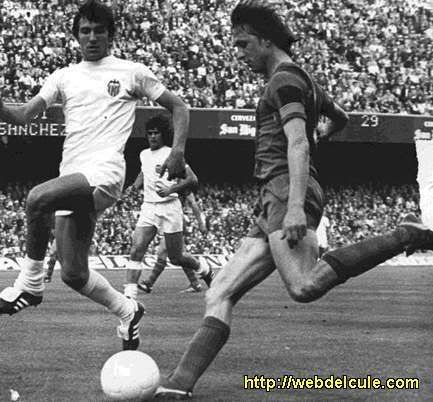
With the team winning the Spanish Cup in 1978, JosepLluis Nuñez became President on 6th May, with a clear message of renovation and rebuilding. The club then began a considerable period of expansion and financial stability linked to an increase in members, ground improvements and, most importantly sporting success. With 30,000 Catalans present at the final, Barca won the Cup Winners Cup in 1979 and then the Spanish League in 1984, under Terry Venables, before the wonderful era of Cruyff's 'dream team' which won four consecutive Spanish Leagues between 1990 and 1994 and the European Cup on 20th May 1992 at Wembley. Then came Bobby Robson, who won the Cup Winners Cup, the Spanish Cup and the Spanish Super Cup in the 1996-97 season and Louis van Gaal's consecutive league titles in 1997-98 and 1998-99, when the team won the double for the first time in 39 years.
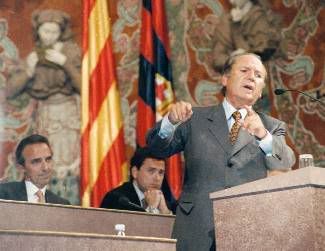
Names such as Migueli, Sánchez, Carrasco, Schuster, Urruti, Maradona, Zubizarreta, Lineker, Bakero, Begiristain, Amor, Koeman, Laudrup, Ferrer, Stòitxkov, Guardiola, Romario, Sergi, Abelardo, Ronaldo, Luis Enrique, Figo, Rivaldo, Kluivert, Puyol and Saviola have all been involved in this wonderful era of success. The celebration of the club's centenary coincided with the arrival of new President Joan Gaspart, whose efforts have been directed to the completion of the new training facilities 'Ciutat Esportiva Joan Gamper' in Sant Joan Despí and La Masia.
The Dream Team (1991-1994)
Zubizarreta, Ferrer, Nando, Koeman, Juan Carlos, Eusebio, Guardiola (113' Alexanco), Bakero, Laudrup, Julio Salinas (64' Goicoechea) y Stoichkov.
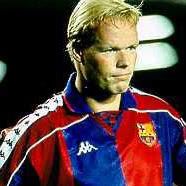
Koeman vs Sampdoria
Biggest crisis: Joan Gaspart
After a bad year in 2000, Nuñez and Van Gaal resigned. Joan Gaspart won the elections and we began the longest era without titles. Many coaches, many unuseful players, many failures and an economical crisis.
Gaspart resigned in 2004 and Laporta won the elections for the presidency. His first big signing was Ronaldinho. Laporta had the task of re-building a destroyed club. He found a solution for the crisis and he made a similar revolution to the one made in 1988. The results began at the end of last season. Six years later, Barça is again an power-house in Spain and Europe.

Laporta Era
By the spring of 2003, the football club with the biggest membership in the world, and the largest stadium in Europe, had sunk into one of the worst crises of its 104-year history. FC Barcelona, or Barça, was crippled by debts and demoralised by the increasingly sad performances of its players, and the moral and financial chaos of their management.
And what followed we all know.
Fc Barcelona's trophies:
Best moments in Barcelona's history:
Fc Barcelona-Arsenal:
Belleti's goal against Arsenal
The end of the match
Camp Nou Fiesta
Real Madrid-Fc Barcelona
Real Madird-Fc Barcelona 0-3
Rivaldo vs Valencia
Fc Barcelona-Real Madrid 5-0
Real Madrid-Fc Barcelona 0-5
Fc Barcelona-Real Madrid 2-1, Copa del Rey
Fc Barcelona-Boca Juniors 9-1, Gamper 84/85
Messi's first goal in Barca
Messi vs Getafe
Messi vs Real Madrid
In the late 90s' of the 19th cenutry Swiss business men Hans (Joan) Gamper and his ten friends (Gualteri Wild, Lluís d'Ossó, Bartomeu Terrados, Otto Kunzle, Otto Maier, Enric Ducal, Pere Cabot, Carles Pujol, Josep Llobet, John Parsons and William Parsons) founded FC Barcelona. The exact date of foundation is the 29th November 1889.
Who was Hans (Joan) Gamper?

He was born in Winterthur, Switzerland on November 22, 1877. He was the eldest son born to August and Rosine Emma Gamper. Even as a young boy he showed great interest in sports especially for football,rugby,tennis and golf. He started his career in Fc Basel and was named club captain but then he moved first to France and in 1898 he went to Barcelona to visit his uncle. In 1899 he put a note in a local newspaper, trying to attract as many football players as possible to join the club; and just one monthe later he and his friends assembled at the historic gathering at the Gimnas Sole. The meeting was successful and the club was established and Englishman Gualteri Wild became the first President with Gamper as the first captain of the club.
Gualteri Wild:

First team from 1901:

Symbols and kits through the course of history
First club symbol was the same as the town symbol:

In 1906 the club organized competition to chose the first club symbol which has changed through the course of history only in the period of Franco's regime (the club was called Club de Futbol Barcelona which can be seen on the symbol as well).
The club symbol represents the Cross of Saint Jordi – the patron saint of Barcelona; flag of Catalunia Senyera (national flag with 4 red lines on the golden background) and blue-red colour combination which Gamper took over from Fc Basel.








The first kit
From the start, the players wore the famous blue and claret colours, half the shirt one colour and half the other with the sleeves the opposite colour and white shorts.

Anthem of Fc Barcelona
[ur=lhttp://penya.fcbarcelonanyc.com/index.php?module=pagemaster&PAGE_user_op=view_page&PAGE_id=73]Anthem[/url]
The first match
In their first ever match, Barca played a team made up of English expatriates in Bonanova (now known as Turo Park). The English team, which actually included a number of Barca players, won 1-0. After the defeat moved several times from Bonanova to Casanova, Camp del Horta and Muntaner. In 1909 the club dwelled at stadium Industria which was the first field as the property of the club. The stadium capacity: 6000 spectators. Fc Barcelona played there for another 13 years.

Les Corts
On 20, May 1922 Barca inaugurate their new stadium which was pretty modern for those times. At the begining the stadium received 30000 spectators and was later expanded to the capacity of 60000 viewers. Fc Barcelona played at Les Corts for 35 years.




Cule. The etymological meaning of this word derives from the word cul which means literally arse in Catalan (pronounced /ku?les/). An approximate translation of this term would be arses. Far from being somewhat offensive or insulting for Barça's fanship, this term was created in the early 20 century, where, while seated in the highest position of the stadium, from outside people saw the bottoms of the fans. This rather humorous term was coined and the fans were called this way ever since. There are about 1,730 FC Barcelona's officially registered supporters clubs around the world (as of November 2005).
Barca's early search for a permanent home saw them playing at the Hotel Casanovas (1900), la carretera d'Horta (1901), el carrer Muntaner (1905) and carrer Indústria, which was the first ground owned by the club and had a capacity of 6,000 with a two tier stand, unique for its time. The ground was officially opened on 14th March 19 1909, by which time the club had already begun to collect titles, having won the Copa Macaya in 1901-02 and the Catalan Championships of 1904-05 and 1908-09. Spurred on by their new surroundings, the club went on to win the Catalan Championships of 1909-10, 1910-11, 1912-13, 1915-16, 1918-19 1919-20, 1920-21 and 1921-22, and the Spanish Championships of 1909-10, 1911-12, 1912-13, 1919-20 and 1921-22, as they enjoyed their first big period of sporting and social expansion.
The decade between 1919 and 1929 is considered a golden age for the club, when the team boasted players such as Samitier, Alcántara, Zamora, Sagi, Piera and Sancho, whose skill drew in the crowds and the club began to take on its identification with Catalan nationalism during a particular difficult period. The 20th May 1922 saw the inauguration of the new Les Corts ground, which soon became known as 'the cathedral of football'. It was a magnificent stadium with a capacity of 30,000, later doubled to 60,000. On the celebration of the club's 25th anniversary in 1924, marked by the famous poster drawn by Valencian artist Josep Segrelles, FC Barcelona had a total of 12.207 members and the future looked bright for the club. Five years later, season 1928-29, Barca won the first of their many Spanish League titles, a fitting climax to a period that had seen them conquer the Catalan Championship in 1923-24, 1924-25, 1925-26, 1926-27 and 1927-28 and the Spanish Championship in 1924-25, 1925-26 and 1927-28. This last victory came after two replays with Real Sociedad and a heroic performance from Barca keeper Franz Platko, which was later celebrated in a poem by Rafael Alberti.
Gamper died on 30th July 1930 and the club went through difficult times for another 10 years because of political conditions in the country. In 1936 Franco's fascists killed the President of Fc Barcelona Josep Sunyol while the club was in America and managed to avoid the same fate. Betwixt the time of the civil war the number of members decreased to 4000 and in 1940 Franco nominated his own President the aristocrat in that time Enrique Pineyro who changed the name of the club into Club de Futbol Barcelona which stayed until the year of 1973 which was 2 years before Franco's death. Besides the alteration of the name Pineyro changed the club's symbols as well. He changed the Catalunia flag with Spanish one (only two lines).
People of Cataunia boiled with rage and Franco got frightened of the possible rebellion as the number of members was increasing with each day. Finally, the club sacked Pineyro and established their leadership. In next 5 years Barca won 3 Spanish trophies with Cesar, Velasco, Ramallets, Curto, brothers Gonzalvo and others at the head.
Barca celebrated their 50th anniversary in 1949 boosted by member numbers of 24,893 and boasting a total of 21 Catalan Championships, 9 cups and 4 Spanish League titles.
Kubala
With the arrival of Ladislau Kubala in June 1950, it soon became clear that Barca were growing too big for their Les Corts ground. Between 1951 and 1953, Barca won every title on offer -the Spanish Leagues of 1951-52 and 1952-53, the Spanish Cup in 1951,52 and 53. During the 1951-52 season, the team won the five cups: Spanish League, Cup, Latin Cup Eva Duarte and Martin Rossi trophies, with their famous forward line of Basora, César, Kubala, Moreno and Manchón.
Kubala nearly went to Madrid but the decisive moment to change his mind was when he had married daughter of Ferdinand Dauchik, who was in contacts with Josep Samitiers then scaut of the club, so he chose Barcelona at the end.

Kubala was huge talent and he scored 7 goals in a single match against Sporting Gijon in his first season in Barca (1951-1952). Barca won that same match 9-0. This season is regarded as the most successful one in the club's history (5 trophies). Next season Kubala played only few matches due to the consumption he had suffered from – but he miraculously returned and helped winning the League and the Cup title, he scored the decisive goal against Atletico in the final.
The Camp Nou
Ladislau Kubala was too huge a figure for Les Corts and the Club went on to open the doors of the Camp Nou (1957). Some of the greatest players in the world have graced its turf (Kubala, Cruyff, Maradona, Schuster, Ronaldo...) and in the 1990s it was the scene of some of the most spectacular football ever played, thanks to the unforgettable 'Dream Team'. And while the Club keeps growing, the stadium is continually being extended and improved.

The first ticket:

1957- 49000 members (socios).
Coach: Helenio Herrera

With Kubala, Martinez, Luis Suarez (the only Spaniard that won the best European player award), Gensana, Segarra, Evaristo and the Hungarian Kocsis and Czibor (both came on the initiative of Kubala) Barca ground everything that crossed its path. Barca won the Spanish League in 1958-59 and 1959-60 as well as the Fairs Cup in 1957-58 and 1959-60. In the sixties Barca won only 3 trophies: the Spanish Cup in 1963 and 1968 and the Fairs Cup in 1966.
Kubala Herrera quarrel:
Kubala missed the semi-final match against Real Madrid in the European Cup in 1961 which Barca eventually lost 6-2. The club leadership backed up Kubala and Herrera had to leave and only one year later Barca defeated Real Madrid in semi-finals in the same competition and lost in the final against Benfica 3-2. Two years later Kubala ended his career and tried his luck as coach of Barcelona but he wasn't so successful and had to leave the club after the defeat against the Red Star Belgrade.
The club became more and more identified with the Catalan society of that time and began to be known as 'more than a club' because of its social importance. The club again became a focus for nationalist sentiments during a period of dictatorship which came down hard on any other popular manifestations of Catalan identity.
»Som més que un club«
Arrival of Johan Cruyff:
The signing of Johan Cruyff put the finishing touches to a wonderful forward line of Rexach, Asensi, Cruyff, Sotil and Marcial, who led the league winning side of 1973-74. Coinciding with the club's 75th anniversary, there were now 70,000 members, making it the most powerful sporting club in the World.

With the team winning the Spanish Cup in 1978, JosepLluis Nuñez became President on 6th May, with a clear message of renovation and rebuilding. The club then began a considerable period of expansion and financial stability linked to an increase in members, ground improvements and, most importantly sporting success. With 30,000 Catalans present at the final, Barca won the Cup Winners Cup in 1979 and then the Spanish League in 1984, under Terry Venables, before the wonderful era of Cruyff's 'dream team' which won four consecutive Spanish Leagues between 1990 and 1994 and the European Cup on 20th May 1992 at Wembley. Then came Bobby Robson, who won the Cup Winners Cup, the Spanish Cup and the Spanish Super Cup in the 1996-97 season and Louis van Gaal's consecutive league titles in 1997-98 and 1998-99, when the team won the double for the first time in 39 years.

Names such as Migueli, Sánchez, Carrasco, Schuster, Urruti, Maradona, Zubizarreta, Lineker, Bakero, Begiristain, Amor, Koeman, Laudrup, Ferrer, Stòitxkov, Guardiola, Romario, Sergi, Abelardo, Ronaldo, Luis Enrique, Figo, Rivaldo, Kluivert, Puyol and Saviola have all been involved in this wonderful era of success. The celebration of the club's centenary coincided with the arrival of new President Joan Gaspart, whose efforts have been directed to the completion of the new training facilities 'Ciutat Esportiva Joan Gamper' in Sant Joan Despí and La Masia.
The Dream Team (1991-1994)
Zubizarreta, Ferrer, Nando, Koeman, Juan Carlos, Eusebio, Guardiola (113' Alexanco), Bakero, Laudrup, Julio Salinas (64' Goicoechea) y Stoichkov.

Koeman vs Sampdoria
Biggest crisis: Joan Gaspart
After a bad year in 2000, Nuñez and Van Gaal resigned. Joan Gaspart won the elections and we began the longest era without titles. Many coaches, many unuseful players, many failures and an economical crisis.
Gaspart resigned in 2004 and Laporta won the elections for the presidency. His first big signing was Ronaldinho. Laporta had the task of re-building a destroyed club. He found a solution for the crisis and he made a similar revolution to the one made in 1988. The results began at the end of last season. Six years later, Barça is again an power-house in Spain and Europe.

Laporta Era
By the spring of 2003, the football club with the biggest membership in the world, and the largest stadium in Europe, had sunk into one of the worst crises of its 104-year history. FC Barcelona, or Barça, was crippled by debts and demoralised by the increasingly sad performances of its players, and the moral and financial chaos of their management.
And what followed we all know.
Fc Barcelona's trophies:
Spanish First Division: 18
1928-29, 1944-45, 1947-48, 1948-49, 1951-52, 1952-53, 1958-59, 1959-60, 1973-74, 1984-85, 1990-91, 1991-92, 1992-93, 1993-94, 1997-98, 1998-99, 2004-05, 2005-06
Spanish Super Cup: 11
1945, 1948, 1952, 1953, 1983, 1991, 1992, 1994, 1996, 2005, 2006
(Known as Copa de Oro Argentina in 1945, and Copa Eva Duarte between 1947 & 1953)
Spanish League Cup: 2
1983, 1986
Copa Del Rey (King's Cup): 24
1909-10, 1911-12, 1912-13, 1919-20, 1921-22, 1924-25, 1925-26, 1927-28, 1941-42, 1950-51, 1951-52, 1952-53, 1956-57, 1962-63, 1967-68, 1970-71, 1977-78, 1980-81, 1982-83, 1987-88, 1989-90, 1996-97, 1997-98
Copa Catalunya: 5
1990-91, 1992-93, 1999-2000, 2003-04, 2004-05
Copa Macaya/Catalan Champions: 22
1901-02, 1904-05, 1908-09, 1909-10, 1910-11, 1912-13, 1915-16, 1918-19, 1919-20, 1920-21, 1921-22, 1923-24, 1924-25, 1925-26, 1926-27, 1927-28, 1929-30, 1930-31, 1931-32, 1933-34, 1935-36, 1937-38
Latin Cup: 2
1949, 1952
Eva Duarte Cup: 3
1948, 1952, 1953
Martini & Rossi Trohpy: 2
1952, 1953
Little World Cup: 1
1957
Joan Gamper Trophy: 32
1966, 1967, 1968, 1969, 1971, 1973, 1974, 1975, 1976, 1977, 1979, 1980, 1983, 1984, 1985, 1986, 1988, 1990, 1991, 1992, 1995, 1996, 1997, 1998, 1999, 2000, 2001, 2002, 2003, 2004, 2005, 2006.
Teresa Herrera Trophy: 5
1948, 1951, 1972, 1990, 1993
Ramon de Carranza Trophy: 2
1961, 1962
Ciudad de Palma Trophy: 5
1969, 1974, 1976, 1980, 1981
Cup of the Pyrenees: 4
1910, 1911, 1912, 1913
Mediterranean League: 1
1937
Best moments in Barcelona's history:
Fc Barcelona-Arsenal:
Belleti's goal against Arsenal
The end of the match
Camp Nou Fiesta
Real Madrid-Fc Barcelona
Real Madird-Fc Barcelona 0-3
Rivaldo vs Valencia
Fc Barcelona-Real Madrid 5-0
Real Madrid-Fc Barcelona 0-5
Fc Barcelona-Real Madrid 2-1, Copa del Rey
Fc Barcelona-Boca Juniors 9-1, Gamper 84/85
Messi's first goal in Barca
Messi vs Getafe
Messi vs Real Madrid
